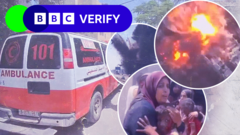Almost 100 strikes have been recorded within Gaza's so-called "humanitarian zone," according to an analysis by BBC Verify. This area, designated by the Israel Defense Forces (IDF) for civilians seeking safety, has faced 97 reported attacks since May 2024. Recent revelations come as efforts for a ceasefire between Israel and Hamas seem to be moving towards a potential breakthrough, with mediators in Qatar indicating that discussions are in their final stages.
The IDF established this humanitarian zone in October 2023, aimed supposedly at protecting civilians and keeping them away from conflict. However, on May 6, 2024, the IDF expanded its parameters to include Khan Younis and Deir al-Balah, both of which are densely populated and home to over a million residents, many living in tents with limited access to aid and basic necessities.
In an official statement to BBC Verify, the IDF maintained that strikes are primarily targeting Hamas militants that allegedly use civilian areas as shields, claiming compliance with international law. This military response follows an attack by Hamas on October 7, 2023, which resulted in significant Israeli casualties and led to the intensified military campaign against the group.
Despite the IDF's framing of the humanitarian zone as a safe area, BBC Verify's findings suggested that attacks in this region have ramped up, with at least 22 strikes this month alone. Local media reports have associated these strikes with the death of more than 550 individuals within this humanitarian area. While the IDF acknowledged 28 of these attacks, the exact number remains unverified.
Gavin Kelleher from the Norwegian Refugee Council described a troubling pattern, stating that strikes occur almost daily, even from naval vessels and drones. "Heavy fire is recurrent in this area despite its supposed humanitarian designation," he noted, suggesting that the IDF's claimed protection of civilians could be more of a façade.
Local testimonies echo this sentiment. Khaled Abdel Rahman, a resident, lamented the persistent insecurity despite relocating to the so-called safe zone. The frequency of bombardments has instilled a climate of fear, challenging the assertion that civilians can find refuge in the designated area.
The limited access of foreign journalists to Gaza complicates the verification of incidents, with local Palestinian reporters often providing the primary accounts of occurrences on the ground. To ascertain the impact of the strikes, BBC Verify analyzed over 300 videos and photographs sourced from social media, observing numerous instances of civilian suffering, including women and children affected by the violence.
The report notes that seven strikes have resulted in the death of more than 20 people each, singlehandedly leading to over 90 fatalities in one incident, which reportedly also killed significant Hamas leadership figures. Further complicating matters, evacuation notices and changes to the boundaries of the 'humanitarian zone' have led to confusion among residents on where they can seek safety.
While the IDF refers to this area as designated for humanitarian efforts and civilian shelters, the United Nations and various humanitarian organizations have consistently refuted the notion of any truly 'safe' zones in Gaza, emphasizing the pervasive risks. Juliette Touma of UNRWA highlighted the harsh reality facing civilians: “There is no place spared; no one is safe."
This concerning situation illustrates the stark contradiction between the IDF's narrative of safety in the humanitarian zone and the lived experiences of its residents amidst the ongoing conflict.





















